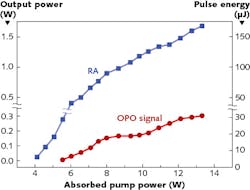High-energy picosecond OPO produces 30.5 μJ pulses at 10 kHz rep rate
Optical parametric oscillators (OPOs) are one of the most important sources of highly coherent light in the infrared (IR) for scientific experimentation. Containing a nonlinear optical crystal and an optical resonator, an OPO converts laser light of shorter wavelengths to a longer wavelength. Continuous-wave (CW) and nanosecond-pulsed OPOs are widely used. However, creating an OPO that can produce picosccond or femtosecond pulses is more difficult, as the cavity length becomes very small. Synchronously pumped OPOs (SPOPOs) avoid this problem by matching the cavity length to the pulse repetition rate (PRR) of the pump laser, but conventional designs produce low pulse energies.
A novel approach by researchers at the Technical Institute of Physics and Chemistry and the University of Chinese Academy of Sciences (both in Beijing, China) has resulted in a high-energy ultrafast OPO via intracavity pumping in a regenerative amplifier (RA) with Nd:YAG as the gain medium. The device, which uses a potassium titanyle arsenate (KTA) nonlinear crystal, produces pulses with a 7 ps width and 30.5 μJ energy at a PRR of 10 kHz from a 1.5 μm singly resonant synchronously pumped OPO. The seed source for the RA was a 1064 nm mode-locked neodymium:vanadate (Nd:YVO4) laser producing 9 ps pulses at a 76 MHz PRR, while the pump laser was a 30 W, 808 nm fiber-coupled laser diode. The researchers believe the technique can be extended to produce pulse energies exceeding 1 mJ, as well as high-energy femtosecond pulses. Reference: L.-J. He et al., prepost, to be published in Opt. Lett., 43, 3 (2018).
About the Author
John Wallace
Senior Technical Editor (1998-2022)
John Wallace was with Laser Focus World for nearly 25 years, retiring in late June 2022. He obtained a bachelor's degree in mechanical engineering and physics at Rutgers University and a master's in optical engineering at the University of Rochester. Before becoming an editor, John worked as an engineer at RCA, Exxon, Eastman Kodak, and GCA Corporation.

